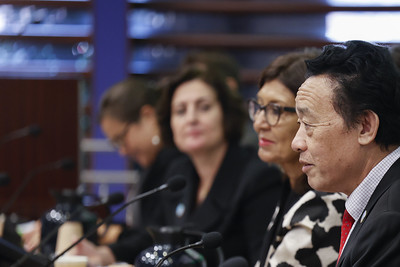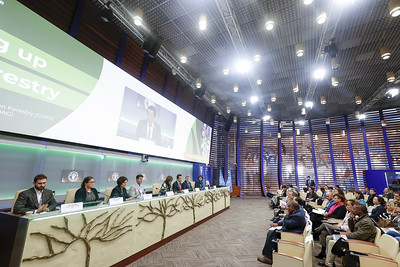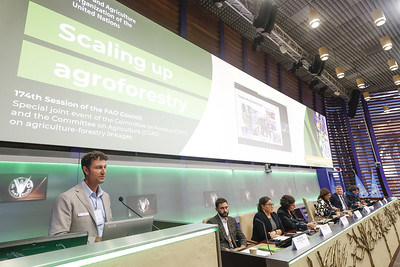FAO promotes agroforestry as a key practice for achieving agrifood systems transformation

©FAO/Riccardo De Luca
On the sidelines of the FAO 174th Session of Council, an event on “Scaling-up agroforestry” examined the linkages between agriculture and forestry, with a focus on how to scale up agroforestry as a means of enhancing synergies between the sectors. There is a growing recognition of the potential for the adoption of agroforestry to help countries and communities to address critical global challenges and crises, including climate change, land degradation and the expansion of the agricultural frontier. FAO Director-General QU Dongyu underscored the socio-economic and environmental benefits of agroforestry in opening the 1.5-hour event held in Rome, Italy, on 7 December 2023. “Agroforestry is a key climate solution with huge potential to simultaneously improve food security and nutrition and alleviate poverty, while halting deforestation, conserving biodiversity, building resilience and helping to reduce greenhouse gas emissions,” he said.
The event was organized jointly by the FAO Committee on Forestry (COFO) and the FAO Committee on Agriculture (COAG), in line with a roadmap on agriculture-forestry linkages to advance cross-sectoral approaches, which are key to transforming agrifood systems. The event was an opportunity to share experiences, foster greater collaboration between the two sectors and discuss barriers to scaling up agroforestry.

©FAO/Riccardo De Luca

©FAO/Riccardo De Luca
“Today’s event highlights the importance of agroforestry as a tangible cross-sectoral approach to enhance synergies and reduce trade-offs between the agriculture and forestry sectors for more sustainable agrifood systems,” said Julie Emond, COAG Chairperson, noting the need for better data, a greater set of practice-relevant evidence and better governance to scale up agroforestry.
“Of the 2.2 billion hectares of degraded land identified as potentially available for restoration worldwide, more than half of it is best suited for mosaic restoration in which trees, forests are combined with other land uses such as agroforestry,” said Günter Walkner, COFO Chairperson, adding that this provides an opportunity, especially for smallholders, local communities and Indigenous Peoples, who own and manage nearly half of the world’s farm and forest landscapes.
Looking back to plan for the future
Michael Taylor, a silvopastoral farmer, started his keynote presentation by acknowledging the Indigenous People, the Anaiwan, whose land his family has been farming on for six generations. “We’ve never considered trees separate from our livestock, our grazing business,” he said in explaining his family’s agroforestry practices that involve raising merino sheep and angus cattle as well as planting trees. Taylor described the challenges and opportunities he and his family face in their business – from developing new skills and making investments to plant 250 000 trees and achieve 23-percent tree cover, to dealing with complicated global markets and price fluctuations. He concluded that action is a catalyst for change and farmers need to be supported to try new methods as both practitioners and innovators.
The audience also heard country perspectives from Australia, Brazil, Lebanon, the Philippines and Zambia, where, like in other parts of the world, trees have long played a key role on farms. The speakers - Keiran Andrusko, Manuel Cláudio Motta Macedo, Chadi H. Mohanna, Ray Thomas Kabigting and Lars Weise – shared what their first-hand observations on the adoption of with agroforestry practices, and notably the need for coherent policies and targeted support, such as through capacity building and financing, that respond to the diversity of both farming conditions and challenges faced.
Elaine Springgay, FAO Forestry Officer, alongside Ivan Landers, FAO Agricultural Officer, outlined FAO’s work on agroforestry and explained that agroforestry can take many forms but is essentially a land management system in which a combination of woody perennials and agricultural crops and/or animals deliberately inhabit the same land area in some spatial and/or temporal arrangement.

©FAO/Riccardo De Luca

©FAO/Riccardo De Luca
“When well designed and managed, agroforestry systems can deliver a broad range of social, economic and environmental benefits,” Landers said, explaining that for farmers to overcome challenges in setting up and running agroforestry operations, support must go beyond putting trees on farm and addressing production constraints. What is needed, he said, is an enabling environment that supports the development of agroforestry value chains and market systems – including appropriate investments, innovations, and incentives that support farmers to manage risks and defray the costs of transitioning to these new systems.
“In the forthcoming years we plan to promote sustainable agroforestry production systems, improve agroforestry monitoring and support the development and implementation of agroforestry national policies and strategies,” Springgay said.
The event was moderated by FAO Deputy Director-General Maria-Helena Semedo. In her closing remarks, FAO Deputy Director-General Beth Bechdol underscored the importance of increasing synergies and cross-cutting work across FAO, and of developing solutions that are appropriate and adapted to local contexts – developed alongside and including farmers.
